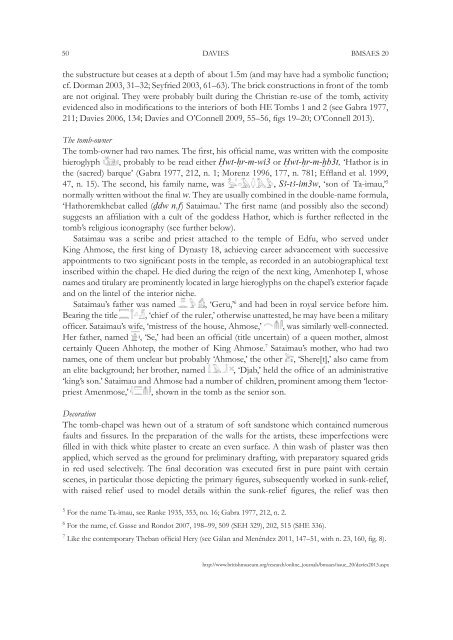The Tomb of Sataimau at Hagr Edfu: An overview - British Museum
The Tomb of Sataimau at Hagr Edfu: An overview - British Museum
The Tomb of Sataimau at Hagr Edfu: An overview - British Museum
You also want an ePaper? Increase the reach of your titles
YUMPU automatically turns print PDFs into web optimized ePapers that Google loves.
50 DAVIES BMSAES 20<br />
the substructure but ceases <strong>at</strong> a depth <strong>of</strong> about 1.5m (and may have had a symbolic function;<br />
cf. Dorman 2003, 31–32; Seyfried 2003, 61–63). <strong>The</strong> brick constructions in front <strong>of</strong> the tomb<br />
are not original. <strong>The</strong>y were probably built during the Christian re-use <strong>of</strong> the tomb, activity<br />
evidenced also in modific<strong>at</strong>ions to the interiors <strong>of</strong> both HE <strong>Tomb</strong>s 1 and 2 (see Gabra 1977,<br />
211; Davies 2006, 134; Davies and O’Connell 2009, 55–56, figs 19–20; O’Connell 2013).<br />
<strong>The</strong> tomb-owner<br />
<strong>The</strong> tomb-owner had two names. <strong>The</strong> first, his <strong>of</strong>ficial name, was written with the composite<br />
hieroglyph , probably to be read either @wt-Hr-m-wi3 or @wt-Hr-m-xb3t, ‘H<strong>at</strong>hor is in<br />
the (sacred) barque’ (Gabra 1977, 212, n. 1; Morenz 1996, 177, n. 781; Effland et al. 1999,<br />
47, n. 15). <strong>The</strong> second, his family name, was , %A-tA-im3w, ‘son <strong>of</strong> Ta-imau,’ 5<br />
normally written without the final w. <strong>The</strong>y are usually combined in the double-name formula,<br />
‘H<strong>at</strong>horemkheb<strong>at</strong> called (Ddw n.f) <strong>S<strong>at</strong>aimau</strong>.’ <strong>The</strong> first name (and possibly also the second)<br />
suggests an affili<strong>at</strong>ion with a cult <strong>of</strong> the goddess H<strong>at</strong>hor, which is further reflected in the<br />
tomb’s religious iconography (see further below).<br />
<strong>S<strong>at</strong>aimau</strong> was a scribe and priest <strong>at</strong>tached to the temple <strong>of</strong> <strong>Edfu</strong>, who served under<br />
King Ahmose, the first king <strong>of</strong> Dynasty 18, achieving career advancement with successive<br />
appointments to two significant posts in the temple, as recorded in an autobiographical text<br />
inscribed within the chapel. He died during the reign <strong>of</strong> the next king, Amenhotep I, whose<br />
names and titulary are prominently loc<strong>at</strong>ed in large hieroglyphs on the chapel’s exterior façade<br />
and on the lintel <strong>of</strong> the interior niche.<br />
<strong>S<strong>at</strong>aimau</strong>’s f<strong>at</strong>her was named , ‘Geru,’ 6 and had been in royal service before him.<br />
Bearing the title , ‘chief <strong>of</strong> the ruler,’ otherwise un<strong>at</strong>tested, he may have been a military<br />
<strong>of</strong>ficer. <strong>S<strong>at</strong>aimau</strong>’s wife, ‘mistress <strong>of</strong> the house, Ahmose,’ , was similarly well-connected.<br />
Her f<strong>at</strong>her, named , ‘Se,’ had been an <strong>of</strong>ficial (title uncertain) <strong>of</strong> a queen mother, almost<br />
certainly Queen Ahhotep, the mother <strong>of</strong> King Ahmose. 7 <strong>S<strong>at</strong>aimau</strong>’s mother, who had two<br />
names, one <strong>of</strong> them unclear but probably ‘Ahmose,’ the other , ‘Shere[t],’ also came from<br />
an elite background; her brother, named , ‘Djab,’ held the <strong>of</strong>fice <strong>of</strong> an administr<strong>at</strong>ive<br />
‘king’s son.’ <strong>S<strong>at</strong>aimau</strong> and Ahmose had a number <strong>of</strong> children, prominent among them ‘lectorpriest<br />
Amenmose,’ , shown in the tomb as the senior son.<br />
Decor<strong>at</strong>ion<br />
<strong>The</strong> tomb-chapel was hewn out <strong>of</strong> a str<strong>at</strong>um <strong>of</strong> s<strong>of</strong>t sandstone which contained numerous<br />
faults and fissures. In the prepar<strong>at</strong>ion <strong>of</strong> the walls for the artists, these imperfections were<br />
filled in with thick white plaster to cre<strong>at</strong>e an even surface. A thin wash <strong>of</strong> plaster was then<br />
applied, which served as the ground for preliminary drafting, with prepar<strong>at</strong>ory squared grids<br />
in red used selectively. <strong>The</strong> final decor<strong>at</strong>ion was executed first in pure paint with certain<br />
scenes, in particular those depicting the primary figures, subsequently worked in sunk-relief,<br />
with raised relief used to model details within the sunk-relief figures, the relief was then<br />
5<br />
For the name Ta-imau, see Ranke 1935, 353, no. 16; Gabra 1977, 212, n. 2.<br />
6<br />
For the name, cf. Gasse and Rondot 2007, 198–99, 509 (SEH 329), 202, 515 (SHE 336).<br />
7<br />
Like the contemporary <strong>The</strong>ban <strong>of</strong>ficial Hery (see Gálan and Menéndez 2011, 147–51, with n. 23, 160, fig. 8).<br />
http://www.britishmuseum.org/research/online_journals/bmsaes/issue_20/davies2013.aspx
















